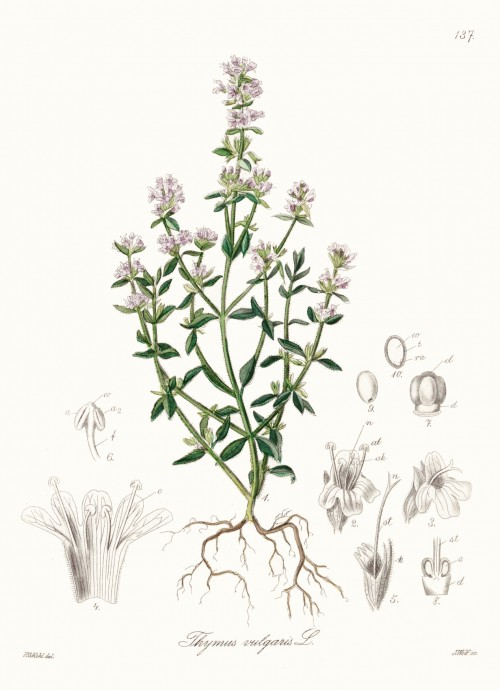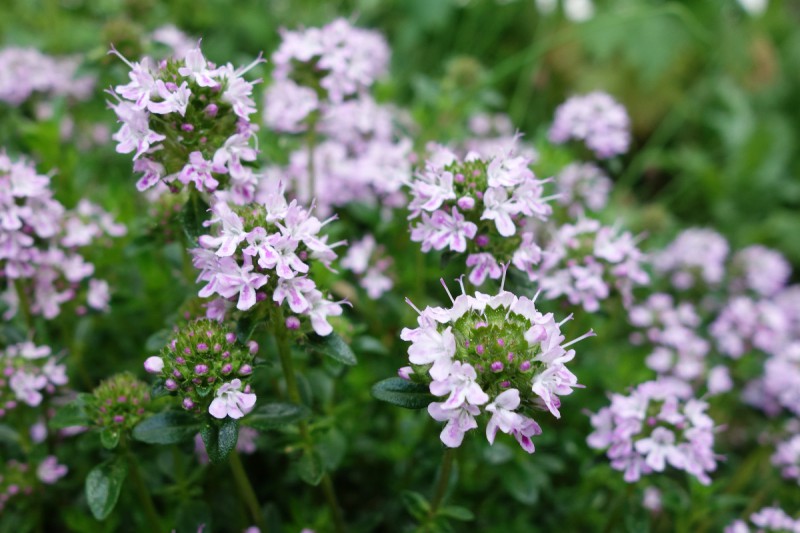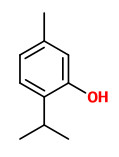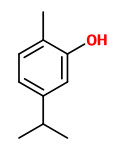Dies ist eine alte Version des Dokuments!
Thymus vulgaris L. - Lamiaceae - common thyme, french thyme, garden thyme, Echter Thymian, Gartenthymian
Evergreen dwarf shrub, native to the western Mediterranean region, naturalizde in Europe, 20-40cm high; square erect twigs, much branched, woody at the base; leaves opposite, lanceolate or ovate, the margins revolute, the underside hoary; flowers pale pink to violet.
„The German Commission E recognized the medical use of essential thyme oil against catarrh of the upper respiratory tract, bronchitis and whooping cough. Essential thyme oil has been proven in laboratory testing antiviral and antibacterial agent, but clinical studies on its effectiveness are missing.“
http://de.wikipedia.org/wiki/Echter_Thymian
„In the essential oil of thyme, 52 compounds were identified, representing 91.4% of the total oil, the major constituents being terpinen-4-ol (13.15%), γ-terpinene (9.21%), cis-sabinene hydrate (7.65%), linalool (7.12%) and p-cymene (5.75%). Tomaino et al. reported that the major constituents of thyme essential oil were thymol (45.3%), p-cymene (26.1%) and linalool (6.17%).“
[Chemical Composition of the Essential Oils Obtained From Some Spices Widely Used in Mediterranean Region. Manuel Viuda-Martos, Yolanda Ruíz-Navajas, Juana Fernández-López, José Angel Pérez-Álvarez, Acta Chim. Slov. 921 2007, 54, 921–926]
„The basic components of the studied thyme oil were thymol (41.33%), p-cymene (18.08%), and γ-terpinene (13.12%). According to Burt (2004), thyme oil consists of 10%-64% thymol and 10%-56% p-cymene.“
[Essential oil of Thymus vulgaris L. and Rosmarinus officinalis L.: Gas chromatography-mass spectrometry analysis, cytotoxicity and antioxidant properties and antibacterial activities against foodborne pathogens. Miladi, H. , Slama, R. , Mili, D. , Zouari, S. , Bakhrouf, A. and Ammar, E., Natural Science, Vol.5, 2013, 729-739] http://file.scirp.org/Html/9-8302003_33090.htm
„Thymol and carvacrol, with oregano, thyme, and spicy notes, were identified as key compounds contributing to the aroma of thyme leaves.“
[Volatile components and key odorants of fennel (Foeniculum vulgare Mill.) and thyme (Thymus vulgaris L.) oil extracts obtained by simultaneous distillation-extraction and supercritical fluid extraction. Díaz-Maroto, M. C., Díaz-Maroto Hidalgo, I. J., Sánchez-Palomo, E., Perez-Coello, M. S., Journal of agricultural and food chemistry, Vol.53(13), 2005, 5385-5389]
There are numerous chemical races with various main components present in the essential oil (1-4%): thymol, carvacrol, p-cymene, linalool and its acetate, alpha-terpineol, campher, geraniol and its acetate. Oils of commerce are dominated by thymol (30-50%), accompanied by p-cymene (15-20%), γ-terpinene (5-10%) and carvacrol (1-5%). The quality standard of Ph.Eur. defines contents of thymol (36-55%), accompanied by p-cymene (15-28%), γ-terpinene (5-10%), linalool (4-6.5%), carvacrol (1-4%) and terpinen-4-ol (0.2-2.5%).
[Gewürzdrogen., Teuscher, E., Bauermann, U., Werner, M., Wissenschaftliche Verlagsgesellschaft, 2003, 386-391]

Kohl,F.G., Die officinellen Pflanzen der Pharmacopoea Germanica, t.137 (1891-1895)
http://plantgenera.org/species.php?id_species=1016624

Thymus vulgaris garden culture, CC BY-SA 3.0, Author: Andreas Kraska






